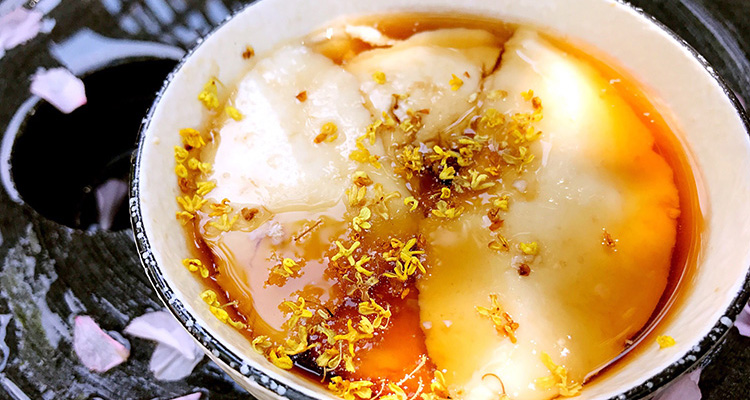Tofu Pudding (Douhua) in China: Sweet & Savory Street Snack Guide
1. Silky and Savory: Discover the Irresistible Charm of Chinese Tofu Pudding
Imagine strolling through a quiet southern Chinese alley on a cool morning, the air filled with the soothing aroma of soybeans and the cheerful cries of street vendors. Following the scent, you find a vendor skillfully scooping a bowl of trembling, silky-white “douhua” — also known as Tofu Pudding — topped with amber-colored syrup or savory sauce.
This humble dish isn’t just a snack — it’s an experience that connects taste, texture, and tradition. Each spoonful tells a story of comfort and culture, inviting every traveler to savor a piece of everyday Chinese life.
2. Origins and History: A Bowl of Tofu Pudding with a Thousand-Year Legacy
The creation of Tofu Pudding (Douhua) is deeply connected to the invention of Tofu, attributed to Liu An, a prince of the Western Han Dynasty more than 2,000 years ago. Tofu pudding can be seen as a delicate “half-formed” version of tofu — created when soy milk begins to set under the action of a coagulant.
Loved by emperors and commoners alike, this dish has stood the test of time. In earlier centuries, a warm bowl of tofu pudding was often the most comforting and nourishing start to the day. With every spoonful, travelers can taste not only the flavor of soybeans but also the long and flavorful history of Chinese cuisine.

3. Cultural Significance: A Taste of North and South
One of the most fascinating aspects of tofu pudding is the famous “sweet vs. savory” debate. This small culinary divide mirrors China’s broader regional flavor map — sweet in the south, savory in the north.
In southern regions like Guangdong and Hong Kong, tofu pudding is often enjoyed as a dessert, served with ginger syrup, brown sugar syrup, red beans, taro balls, or fresh fruit — sweet, smooth, and refreshing. In northern cities such as Beijing and Shandong, it becomes a hearty breakfast or snack, topped with soy sauce, pickled vegetables, dried shrimp, seaweed, coriander, or chili oil — rich, salty, and satisfying.
Neither version is superior; each reflects China’s regional diversity and culinary creativity. For travelers, tasting both versions offers a delicious way to understand local traditions and lifestyles.
4. Flavor and Texture: A Gentle Encounter on the Tongue
No matter the style, the true charm of tofu pudding lies in its incredible texture — so soft it almost melts on contact. When the smooth tofu pudding slips into your mouth, it dissolves instantly, leaving a warm soybean aroma behind.
Sweet tofu pudding offers a delicate balance of sweetness and bean fragrance, while savory tofu pudding delights with layers of salty, umami, and spicy notes. Each spoonful feels like a tender embrace from Chinese comfort food culture.

5. How to Eat and Enjoy
When to eat: Tofu pudding is a treat for any time of day. A warm savory version in the morning awakens the senses, while an iced sweet version in the afternoon refreshes the body. Late at night, it makes for a gentle midnight snack.
How to choose: Follow the locals. In Guangzhou, order a bowl of ginger syrup tofu pudding at a traditional dessert shop; in Beijing, try the savory version from a breakfast stall.
Pairing tips: Savory tofu pudding goes perfectly with fried dough sticks (youtiao) or sesame flatbreads, while sweet tofu pudding makes a lovely dessert after a big meal.
6. Travel Tips: Where and How to Try It
Where to eat: The best tofu pudding is often found at small breakfast stalls, night markets, or century-old dessert shops tucked away in narrow alleys. Look for the ones with long queues — they rarely disappoint.
How to order: Simple words or gestures will do. Say “sweet tofu pudding” or “savory tofu pudding” (in Chinese, “甜豆花” or “咸豆花”). Watch the toppings on the counter to understand the flavors available.
Be adventurous: Don’t shy away from unfamiliar ingredients — they’re part of the local flavor experience. Just let the vendor know if you have any dietary restrictions.

7. Easy Homemade Recipe: Bring the Taste of China Home
Even after your trip, you can easily recreate this beloved dish at home.
Ingredients: 1 liter unsweetened soy milk, 3 grams of coagulant (glucono delta-lactone, available online).
Steps:
- Heat soy milk to 85–90°C (just before boiling).
- Dissolve the coagulant in a large bowl with warm water.
- Pour the hot soy milk quickly into the bowl and do not stir.
- Cover and rest for 15–20 minutes until it sets into silky tofu pudding.
- Add syrup, soy sauce, or any toppings you like!
A simple bowl of tofu pudding carries centuries of culinary wisdom and a spirit of comfort that connects people across China. Whether sweet or savory, it bridges north and south, warming countless hearts along the way.
On your next trip to China, take a morning or afternoon to sit at a humble street stall and savor this “melt-in-your-mouth” national favorite. One silky spoonful might just become your sweetest memory of the city.


